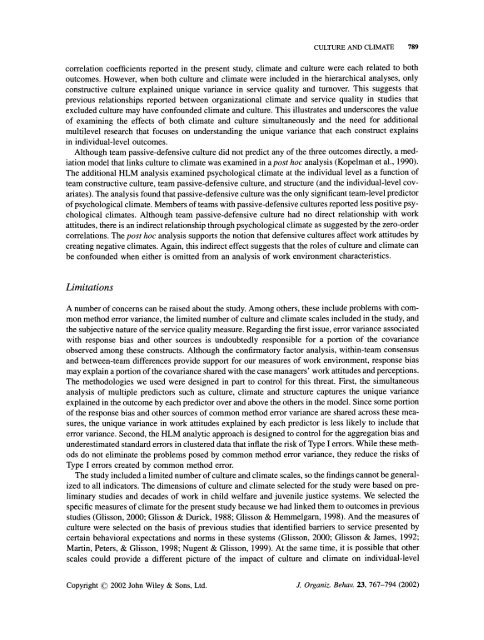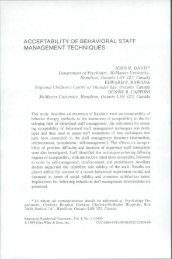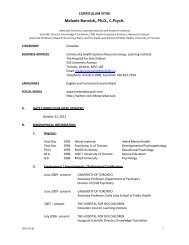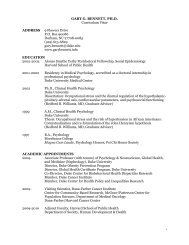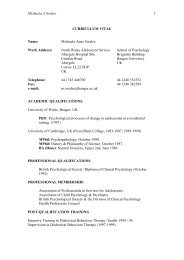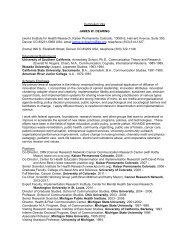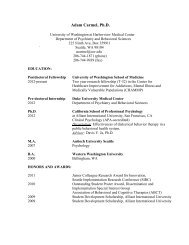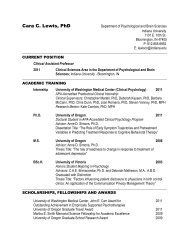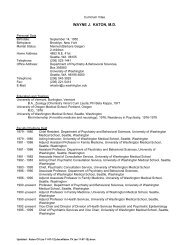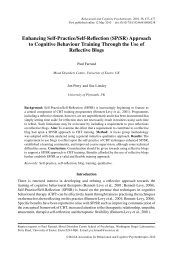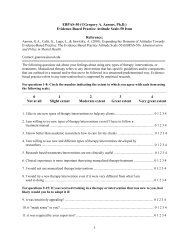The Cross-Level Effects of Culture and Climate in Human Service ...
The Cross-Level Effects of Culture and Climate in Human Service ...
The Cross-Level Effects of Culture and Climate in Human Service ...
You also want an ePaper? Increase the reach of your titles
YUMPU automatically turns print PDFs into web optimized ePapers that Google loves.
CULTURE AND CLIMATE 789<br />
correlation coefficients reported <strong>in</strong> the present study, climate <strong>and</strong> culture were each related to both<br />
outcomes. However, when both culture <strong>and</strong> climate were <strong>in</strong>cluded <strong>in</strong> the hierarchical analyses, only<br />
constructive culture expla<strong>in</strong>ed unique variance <strong>in</strong> service quality <strong>and</strong> turnover. This suggests that<br />
previous relationships reported between organizational climate <strong>and</strong> service quality <strong>in</strong> studies that<br />
excluded culture may have confounded climate <strong>and</strong> culture. This illustrates <strong>and</strong> underscores the value<br />
<strong>of</strong> exam<strong>in</strong><strong>in</strong>g the effects <strong>of</strong> both climate <strong>and</strong> culture simultaneously <strong>and</strong> the need for additional<br />
multilevel research that focuses on underst<strong>and</strong><strong>in</strong>g the unique variance that each construct expla<strong>in</strong>s<br />
<strong>in</strong> <strong>in</strong>dividual-level outcomes.<br />
Although team passive-defensive culture did not predict any <strong>of</strong> the three outcomes directly, a mediation<br />
model that l<strong>in</strong>ks culture to climate was exam<strong>in</strong>ed <strong>in</strong> a post hoc analysis (Kopelman et al., 1990).<br />
<strong>The</strong> additional HLM analysis exam<strong>in</strong>ed psychological climate at the <strong>in</strong>dividual level as a function <strong>of</strong><br />
team constructive culture, team passive-defensive culture, <strong>and</strong> structure (<strong>and</strong> the <strong>in</strong>dividual-level covariates).<br />
<strong>The</strong> analysis found that passive-defensive culture was the only significant team-level predictor<br />
<strong>of</strong> psychological climate. Members <strong>of</strong> teams with passive-defensive cultures reported less positive psychological<br />
climates. Although team passive-defensive culture had no direct relationship with work<br />
attitudes, there is an <strong>in</strong>direct relationship through psychological climate as suggested by the zero-order<br />
correlations. <strong>The</strong> post hoc analysis supports the notion that defensive cultures affect work attitudes by<br />
creat<strong>in</strong>g negative climates. Aga<strong>in</strong>, this <strong>in</strong>direct effect suggests that the roles <strong>of</strong> culture <strong>and</strong> climate can<br />
be confounded when either is omitted from an analysis <strong>of</strong> work environment characteristics.<br />
Limitations<br />
A number <strong>of</strong> concerns can be raised about the study. Among others, these <strong>in</strong>clude problems with common<br />
method error variance, the limited number <strong>of</strong> culture <strong>and</strong> climate scales <strong>in</strong>cluded <strong>in</strong> the study, <strong>and</strong><br />
the subjective nature <strong>of</strong> the service quality measure. Regard<strong>in</strong>g the first issue, error variance associated<br />
with response bias <strong>and</strong> other sources is undoubtedly responsible for a portion <strong>of</strong> the covariance<br />
observed among these constructs. Although the confirmatory factor analysis, with<strong>in</strong>-team consensus<br />
<strong>and</strong> between-team differences provide support for our measures <strong>of</strong> work environment, response bias<br />
may expla<strong>in</strong> a portion <strong>of</strong> the covariance shared with the case managers' work attitudes <strong>and</strong> perceptions.<br />
<strong>The</strong> methodologies we used were designed <strong>in</strong> part to control for this threat. First, the simultaneous<br />
analysis <strong>of</strong> multiple predictors such as culture, climate <strong>and</strong> structure captures the unique variance<br />
expla<strong>in</strong>ed <strong>in</strong> the outcome by each predictor over <strong>and</strong> above the others <strong>in</strong> the model. S<strong>in</strong>ce some portion<br />
<strong>of</strong> the response bias <strong>and</strong> other sources <strong>of</strong> common method error variance are shared across these measures,<br />
the unique variance <strong>in</strong> work attitudes expla<strong>in</strong>ed by each predictor is less likely to <strong>in</strong>clude that<br />
error variance. Second, the HLM analytic approach is designed to control for the aggregation bias <strong>and</strong><br />
underestimated st<strong>and</strong>ard errors <strong>in</strong> clustered data that <strong>in</strong>flate the risk <strong>of</strong> Type I errors. While these methods<br />
do not elim<strong>in</strong>ate the problems posed by common method error variance, they reduce the risks <strong>of</strong><br />
Type I errors created by common method error.<br />
<strong>The</strong> study <strong>in</strong>cluded a limited number <strong>of</strong> culture <strong>and</strong> climate scales, so the f<strong>in</strong>d<strong>in</strong>gs cannot be generalized<br />
to all <strong>in</strong>dicators. <strong>The</strong> dimensions <strong>of</strong> culture <strong>and</strong> climate selected for the study were based on prelim<strong>in</strong>ary<br />
studies <strong>and</strong> decades <strong>of</strong> work <strong>in</strong> child welfare <strong>and</strong> juvenile justice systems. We selected the<br />
specific measures <strong>of</strong> climate for the present study because we had l<strong>in</strong>ked them to outcomes <strong>in</strong> previous<br />
studies (Glisson, 2000; Glisson & Durick, 1988; Glisson & Hemmelgarn, 1998). And the measures <strong>of</strong><br />
culture were selected on the basis <strong>of</strong> previous studies that identified barriers to service presented by<br />
certa<strong>in</strong> behavioral expectations <strong>and</strong> norms <strong>in</strong> these systems (Glisson, 2000; Glisson & James, 1992;<br />
Mart<strong>in</strong>, Peters, & Glisson, 1998; Nugent & Glisson, 1999). At the same time, it is possible that other<br />
scales could provide a different picture <strong>of</strong> the impact <strong>of</strong> culture <strong>and</strong> climate on <strong>in</strong>dividual-level<br />
Copyright ?<br />
2002 John Wiley & Sons, Ltd. J. Organiz. Behav. 23, 767-794 (2002)


